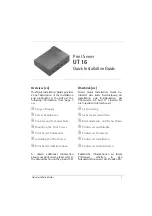
Overview
87
SIPxNano IP-PBX Getting Started Guide
A • Session Initiation Protocol (SIP)
Overview
The Session Initiation Protocol (SIP) establishes a standard methodology for setting up, maintaining, and end-
ing interactive communication sessions. To perform these tasks, SIP, like HTTP (Hypertext Transfer Protocol),
uses a request-response model in which messages are exchanged by system components.
The particular content of a session is described in, but not included with, SIP messages. Phones that use SIP to
manage the transmission of voice data during phone calls can also be used for the transmission of other types of
data, such as video, fax, and multimedia.
Note
SIP messages may actually travel over different networks than the audio or
video packets they describe.
This section introduces the contents of SIP messages and describes how the messages are organized into trans-
actions, sessions, and calls. The Internet Engineering Task Force (IETF) Request for Comments (RFC) 3261
provides the specification for the SIP protocol.
SIP Messages
SIP is ASCII-based. All SIP messages are formatted as text using HTTP syntax. SIP messages contain call con-
trol methods for requests or response codes for replies, and are exchanged to:
•
Initiate a session between an originator and a target. This involves:
-
Locating the target
-
Determining whether or not the target is available
-
Determining the media capabilities of the target
•
Establish a connection between the originator and the target
•
End the session by terminating or transferring the connection
Descriptions of the SIP methods and response codes, the required fields in SIP message headers, SIP URLs,
and examples of SIP messages and message flows follow.
















































